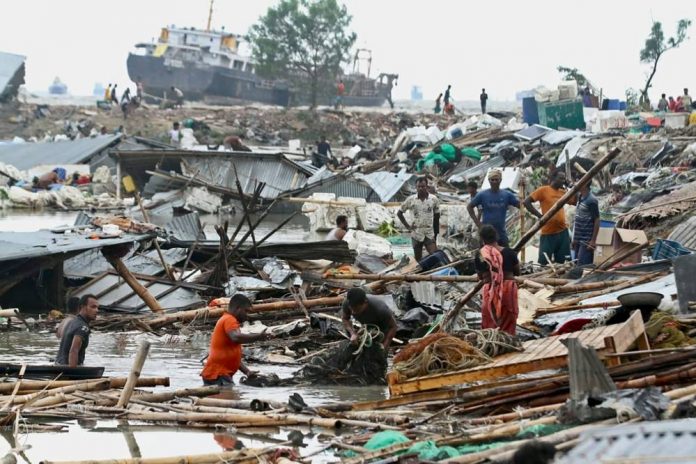DM Monitoring
DHAKA: At least nine people have died after a cyclone slammed into Bangladesh, forcing the evacuation of around a million people from their homes, officials said Tuesday.
Cyclones — the equivalent of hurricanes in the Atlantic or typhoons in the Pacific — are a regular menace but scientists say climate change is likely making them more intense and frequent. Cyclone Sitrang made landfall in southern Bangladesh late Monday but authorities managed to get about a million people to safety before the monster weather system hit.
“Nine people have died, most by trees falling including three from one family in (the eastern district of) Cumilla”, Jebun Nahar, a government official, told media. People evacuated from low-lying regions such as remote islands and river banks were moved to thousands of multi-storey cyclone shelters, Disaster Management Ministry secretary Kamrul Ahsan told media. “They spent the night in cyclone shelters,” he said. In some cases police had to cajole villagers who were reluctant to abandon their homes, officials said. Heavy rains lashed much of the country, flooding cities such as Dhaka, Khulna and Barisal – which witnessed 324 millimetres (13 inches) of rainfall on Monday.
About 33,000 Rohingya refugees from Myanmar, controversially relocated from the mainland to a storm-prone island in the Bay of Bengal, were ordered to stay indoors and there were no reports of any casualties or damage, officials said.
In the neighbouring eastern Indian state of West Bengal, thousands of people were evacuated Monday to more than 100 relief centres, officials said, but there were no reports of damage and people were returning home on Tuesday.
Cyclone Amphan, the second “super cyclone ” ever recorded over the Bay of Bengal, which hit in 2020, killed more than 100 people in Bangladesh and India, and affected millions.
“It was terrible. It looked like the sea was coming to grab us,” Mizanur Rahman, a resident of Bhola district, told reporters after communications were restored in his neighbourhood. “We spent a sleepless night, all we could do was pray.”
The cyclone barrelled in from the Bay of Bengal with winds gusting up to 88 kph (55 mph) and a storm surge of about 3 meters (10 feet) that flooded low-lying coastal areas. Power and telephone links have largely been cut and coastal areas plunged into darkness, officials said.
Around 2,000 electric poles were damaged, leaving 8 million people without electricity, said Nasrul Hamid, junior minister for power, energy and mineral resources. “Efforts are underway to restore electricity as soon as possible,” he told reporters.
Most of the people killed were crushed by falling trees. Some 10,000 homes, 6,000 hectares (14,826 acres) of cropland and 1,000 fishing enclosures were damaged by the cyclone, Enamur Rahman, the junior minister for disaster management, told reporters.
No major damage was reported in refugee camps in southeast Bangladesh, where more than a million ethnic Rohingya refugees from neighbouring Myanmar are living in flimsy shelters.
Officials advised nearly 32,000 Rohingya refugees who had moved from the camps to a flood-prone island in the Bay of Bengal to stay indoors. “We felt the force of the strong wind but were spared,” Rohingya refugee Mohammed Arman told Reuters by phone.
Heavy rain fell on the streets of the capital, Dhaka, causing some flooding and disruption to commuters. The cyclone also affected the eastern Indian state of West Bengal.
South Asia has experienced increasing extreme weather in recent years causing large-scale damage. Environmentalists warn that climate change could lead to more disasters, especially in places like densely populated Bangladesh.
Farah Kabir, Bangladesh country director of ActionAid group, said 2022 had climate emergencies such as floods and droughts “on a scale that has never been witnessed before”.
“The climate crisis is growing, and here in Bangladesh we feel its ferocity,” he said. “When extreme weather events like Cyclone Sitrang strike, communities are left devastated. We urgently need access to funds that support communities living through the reality of the climate crisis.”
In recent years, better forecasting and more effective evacuation planning have dramatically reduced the death toll from such storms. The worst recorded, in 1970, killed hundreds of thousands of people.




